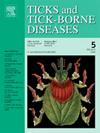蜱传脑炎的临床表现和预后:系统性文献综述
IF 3.4
2区 医学
Q2 INFECTIOUS DISEASES
引用次数: 0
摘要
蜱传脑炎(TBE)由病毒感染引起,可导致中枢神经系统和外周神经系统的急性和持续性损伤。最近,蜱传脑炎在欧洲的发病率有所上升,疾病的流行模式也发生了变化,这说明我们需要更好地了解这种疫苗可预防的疾病。虽然结核病在许多国家都有流行,但对结核病的疾病谱却没有很好的描述。我们试图通过估算出现各种表现的结核病患者比例以及儿童和成人分别出现不良后果的风险,来描述结核病的临床表现和结果。我们于 2022 年 8 月 2 日对 2007 年 1 月 1 日以来以任何语言发表的文章进行了系统性文献综述。在已确定文章的参考文献列表中还发现了其他相关研究。综述仅限于欧洲亚型结核病病毒流行的国家。在已确定和审查的 1632 篇标题和摘要中,有 21 篇被保留下来进行数据分析。这 21 篇研究分为主要分析(15 篇研究报告了实验室确诊的结核病住院患者)和辅助分析(6 篇研究报告了实验室确诊的结核病住院和非住院患者)。主要分析包括 5012 名成人和 640 名儿童。成人的主要临床表现是脑炎(61%),其次是脑膜炎(33%)、根管炎(14%)和脊髓炎(6%)(这些表现是独立评估的,因此总和不会达到 100%)。剔除异常值后,成人中患脑炎(48%)和脑膜炎(44%)的比例相似。在儿童病例中,脑膜炎(77%)是最常见的表现,而脑炎(23%)和脊髓炎(1.3%)的发病率较低。在住院的结核病患者中,成人(分别为 15.5% 和 0.9%)和儿童(分别为 16.4% 和 0%)入住重症监护室(ICU)和死亡的比例相似。由于研究的异质性、中枢神经系统疾病临床表现分类的差异性、分母人群的差异性以及各国医疗保健系统和诊断方法的差异,汇总证据具有挑战性。我们的研究显示,成人和儿童结核病住院患者的临床表现模式各不相同,而且两个年龄组的患者都有很高的入住重症监护室和长期神经系统后遗症的比例。这些发现表明,仍有必要对高危人群采取预防措施。此外,由于研究入院标准的差异,包括临床表现分类的困难,需要采用更加标准化的方法来总结欧洲各地的结核病表现和结果。本文章由计算机程序翻译,如有差异,请以英文原文为准。
Clinical manifestations and outcomes of Tick-borne encephalitis: A systematic literature review
Tick-borne encephalitis (TBE) is caused by a viral infection and can lead to acute and persistent damage to the central and peripheral nervous systems. Recently, the incidence of TBE in Europe has risen, and epidemiological patterns of disease have changed, emphasising the need for improved understanding of this vaccine-preventable disease. Although TBE is endemic in many countries, the disease spectrum of TBE is not well described. We sought to characterise the clinical manifestations and outcomes of TBE by estimating the proportions of TBE patients with each type of manifestation and the risk of adverse outcomes for children and adults separately. A systematic literature review was conducted on 2 August 2022 for articles published in any language since 1 January 2007. Additional relevant studies were found in reference lists of identified articles. The review was limited to countries where only the European subtype of TBEV circulates. Of the 1,632 unique titles and abstracts identified and reviewed, 21 were retained for data analysis. The 21 studies were split into a main analysis (15 studies reporting patients hospitalised with laboratory-confirmed TBE) and a secondary analysis (6 studies reporting hospitalised and non-hospitalised patients who sought medical treatment for laboratory-confirmed TBE). The main analysis included 5,012 adults and 640 children. The predominant clinical manifestation in adults was encephalitis (61 %), followed by meningitis (33 %), radiculitis (14 %), and myelitis (6 %) (the manifestations were evaluated independently, so they will not sum to 100 %). With outliers removed, similar proportions of adults had encephalitis (48 %) and meningitis (44 %). Among cases in children, meningitis (77 %) was the most common manifestation, whereas encephalitis (23 %) and myelitis (1.3 %) were less frequent. Among hospitalised patients with TBE, the proportion of intensive care unit (ICU) admissions and deaths were similar for adults (15.5 % and 0.9 %, respectively) and children (16.4 % and 0 %, respectively.) The percentage of patients with sequelae when examined >12 months from acute TBE was 39.5 % for adults and 16.2 % for children. The evidence was challenging to aggregate due to study heterogeneity, variability in categorising clinical manifestations of central nervous system disease, variability of denominator populations, and differences in healthcare systems and diagnostic practices across countries. Our study disclosed distinct patterns of clinical manifestation among hospitalised adult and child patients with TBE and a high proportion of ICU admissions and long-term neurological sequelae across both age groups. These findings reinforce the continued need for preventive measures in the populations at risk. Moreover, variability of study admission criteria, including difficulty with clinical manifestation categorisation, calls for a more standardised approach to summarising TBE manifestations and outcomes across Europe.
求助全文
通过发布文献求助,成功后即可免费获取论文全文。
去求助
来源期刊

Ticks and Tick-borne Diseases
INFECTIOUS DISEASES-MICROBIOLOGY
CiteScore
6.90
自引率
12.50%
发文量
185
审稿时长
6-12 weeks
期刊介绍:
Ticks and Tick-borne Diseases is an international, peer-reviewed scientific journal. It publishes original research papers, short communications, state-of-the-art mini-reviews, letters to the editor, clinical-case studies, announcements of pertinent international meetings, and editorials.
The journal covers a broad spectrum and brings together various disciplines, for example, zoology, microbiology, molecular biology, genetics, mathematical modelling, veterinary and human medicine. Multidisciplinary approaches and the use of conventional and novel methods/methodologies (in the field and in the laboratory) are crucial for deeper understanding of the natural processes and human behaviour/activities that result in human or animal diseases and in economic effects of ticks and tick-borne pathogens. Such understanding is essential for management of tick populations and tick-borne diseases in an effective and environmentally acceptable manner.
 求助内容:
求助内容: 应助结果提醒方式:
应助结果提醒方式:


